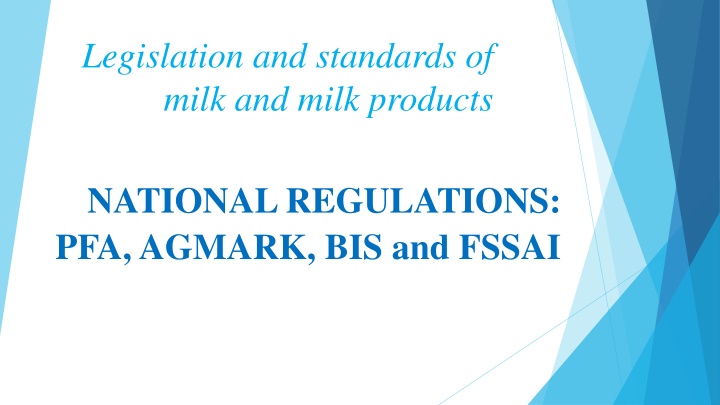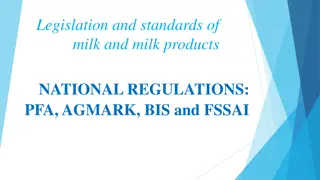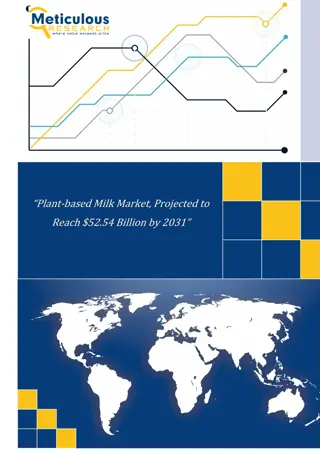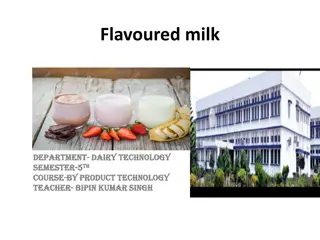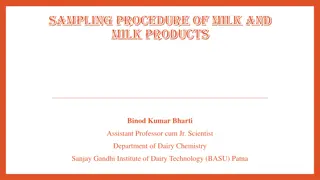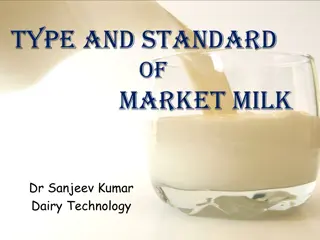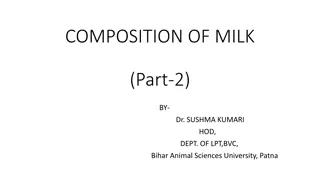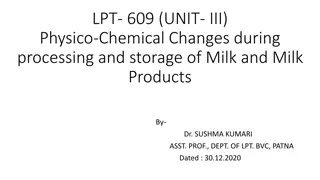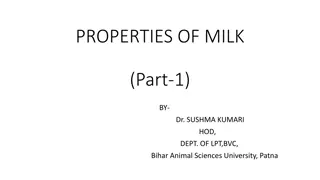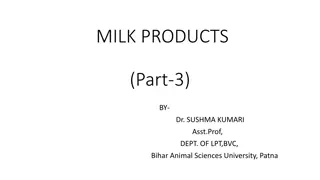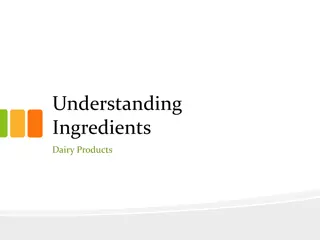Milk and Milk Products: Regulations and Standards in India
The regulations and standards for milk and milk products in India are governed by national bodies such as PFA, AGMARK, BIS, and FSSAI. Legal standards set by the government ensure minimum requirements for quality, composition, hygiene, labeling, and packaging. Quality standards, like BIS and Agmark, are voluntary. Harmonizing Indian standards with international norms is crucial for trade. The concept of globalization has also influenced the evolution of uniform standards, led by the Food Safety and Standards Authority of India (FSSAI).
Download Presentation

Please find below an Image/Link to download the presentation.
The content on the website is provided AS IS for your information and personal use only. It may not be sold, licensed, or shared on other websites without obtaining consent from the author.If you encounter any issues during the download, it is possible that the publisher has removed the file from their server.
You are allowed to download the files provided on this website for personal or commercial use, subject to the condition that they are used lawfully. All files are the property of their respective owners.
The content on the website is provided AS IS for your information and personal use only. It may not be sold, licensed, or shared on other websites without obtaining consent from the author.
E N D
Presentation Transcript
Legislation and standards of milk and milk products NATIONAL REGULATIONS: PFA, AGMARK, BIS and FSSAI
In India, we have mostly two types of standards: Legal standards and Quality standards. Moreover, we had many bodies enforcing standards. This led to lot of confusion for both => manufacturers as well as enforcers. In the recent past the concept of globalization has emerged very strongly => where all the boundaries have been eliminated.
Some barriers to trade with respect to => more stringent norms and others have been raised. In this context Indian Standards needed to be harmonized within themselves as well as with the international standards. To eliminate the problems and confusions in the trade of food items including milk a thought of uniform standards was evolved which has been culminated in the form of Food Safety and Standards Authority of India.
Legal Standards specifications or requirements which pertain to law of the Govt. and are set up by the Govt. to meet certain minimum requirements in terms of chemical quality (i.e. composition), bacteriological quality (i.e. hygienic quality), and labeling and packaging requirements.
In our country, legal standards are given under PFA Rules, 1955 (which are amended from time to time). Legal standards or PFA standards prescribe minimum requirements for all types and categories of food. These standards are consistent with the minimum quality that is attainable under Indian conditions by majority of farmers, producers, processors, sale agencies etc. Further, any food that does not confirm to the minimum standards laid down by the legal rulers (PFA rules) is said to be adulterated, irrespective whether anything has been added to or removed from the original food.
Parameters Generally Taken into Consideration while Fixing Legal Standards: 1 Purity 2 Composition 3 Additives 4 Efficiency of processing 5 Bacteriological quality (Hygienic quality) 6 Packaging and labeling requirements
Quality standards While legal standards are compulsory, the quality standards are not compulsory. They are on voluntary basis. In our country, we have two types of quality standards: BIS/ ISI standards Agmark standards
Both of these are above the PFA minimum standards and useful for producing export quality products. BIS/ISI standards deal with many types of processed food products, apart from non-food products. Agmark standards deal with many types of foods, mainly with the raw agricultural produce. For example: cereals, oils, oil seeds, spices, eggs, legumes (pulses), ghee, butter etc.
Among dairy products, for the purpose of quality standards, ghee and creamery butter (Table butter or salted butter) are covered under Agmark. Rest of the dairy products are covered under BIS/ISI. Agmark and BIS are voluntary and not compulsory; but in 1987, BIS has made it compulsory or mandatory for certain items to have ISI mark food colors and additives, vanaspati, containers for packing, milk powder and condensed milk. Therefore, for these two milk products (milk powder and condensed milk), it is now compulsory to have ISI mark.
Why Do We Need Legal and Quality Standards? customer also wants to be sure about quality. someone has to protect the interest of the consumer. They should not be left at the mercy of the manufacturers, because he is ignorant about the quality. Consumer should get a product of pure quality (i.e. unadulterated) free from pathogenic organisms and also free from harmful substances like pesticides, antibiotics, heavy metals (toxic metals like Arsenics, lead, mercury etc), and toxins etc. So, it is the duty of the Govt. to fix legal standards to protect the interest of the consumer and also to fix quality standards so as to improve the quality of the product to a higher degree above the minimum legal (PFA) standards.
PFA Act and Rules PFA => Prevention of Food Adulteration. PFA Act was passed in 1954 and PFA Rules were framed in 1955 to => protect consumers against the supply of inferior quality or adulterated food. In recent years the Govt. of India has enacted another Act known as The Food Safety and Standards Act, 2006, abbreviated as FSS Act 2006. The regulations under this act have come into force from Aug, 2011.
The main objectives of PFA Act are: To protect the public from harmful and poisonous foods. To prevent the sale of substandard food containing harmful substances, and To protect the society against unscrupulous and anti-social dealers by eliminating fraudulent practices.
PFA standards are formulated and revised by an expert body called Central Committee for Food standards (CCFS) under the Directorate General of health Services, Ministry of Health and Family Welfare. It is the CCFS which advices the Central Govt. and the State Govt. on matters arising out of the administration of PFA Act. It is a very heavy committee . People from all the States and the Union Territories (UTs) and all the major Ministries and departments are representative of this committee.
There are only four CFL (central food laboratories) in the country. These are located at Kolkata, Mysore, Pune and Ghaziabad. take care of the requirements of whole country, Zone wise. In fact the whole country is divided into 4 Zones and each zone is then connected to one of these CFL. Samples of a particular area/zone are sent to the concerned CFL.
Preservative Permitted To Be Added To Samples Preservative used in the case of samples of any milk (including toned, separated and skimmed milk), standardized milk chhanna, skimmed milk chhanna, cream, ice-candy, dahi, khoa or khoa based or paneer based sweets, such as kalakand and burfi, chutney and prepared foods, gur, coffee and tea in liquid and semi liquid form, shall be the liquid commonly known as formalin, a liquid containing about 40 percent of formaldehyde in aqueous solution in the proportion of 0.1 ml (two drops) for 25ml or 25grams (i.e.@ 0.4%). Provided that in case of icecream and mixed ice-cream, the preservative used shall be in the proportion of 0.6 ml for 100 ml or 100 gm (i.e.@ 0.6%).
Agriculture Produce (Grading and Marking) Act (AGMARK) Agmark stands for Agricultural Marking. In order to have a systematic marketing of Agricultural Produce on the basis of well defined quality, Indian Legislature in 1937 passed an act known as Agriculture Produce (Grading and Marking) Act, 1937. This act is not mandatory. It is permissive in nature. It is one s choice to go for Agmark grading, if one can meet their specifications. Rules under this Act are called General Grading and Marking Rules, 1937.
Rules have been revised in 1988 and are called General Grading & Marking Rules, 1988. Grading of Agricultural items under these rules is called AGMARK GRADING or Agmark certification. Agmark is the exclusive property of Govt. of India. It is not a private trade mark. Directorate of Marketing & Inspection (DMI) is the authority on the Agmark whose head quarter is now at Faridabad and branched head quarter is at Nagpur.
It is the DMI which enforces Agricultural Produce Act, 1937. Under Agricultural Produce Act, 1937- grade standards are given for agricultural and allied commodities like cereals, oil seeds, oils, creamery butter, ghee, legumes, eggs etc. Agricultural commodities are categorized into various grades such as, special, good, fair, ordinary etc depending upon the degree of quality (type of composition) in each case. These grades are known as Agmark Standards and this way of categorizing or grading the agricultural products in terms of their chemical composition or quality is called Agmark Grading.
Objectives of Agmark Scheme To assure the consumers a product of pre-tested quality & purity. To enable the producer of good quality products to have better returns. To have a sale of the product in the market with a uniform composition and well defined quality. To eliminate the malpractice of adulteration in the movement of the product from producer to consumer. Among dairy products, only ghee and creamery butter (Table butter or salted butter) are graded under Agmark. Deshi or cooking (unsalted or white) butter is not graded under Agmark.
Bureau of Indian Standards (B.I.S.): A national standards body of India which is responsible for formulating National Standards for various types of articles (both edible & nonedible i.e. food & non-food articles e.g. live stock feed, cattle housing, equipments, dairy products, food additives, food hygiene), testing apparatus and methods etc. The old name of this organization was ISI (Indian Standards Institution), which was established in 1947. The new name i.e. BIS came into existence from 1st April, 1987 under the BIS Act 1986.
Structure of BIS/ Members of BIS Membership of BIS is broad based and all important interests are represented. Minister for food and civil supplies is the President of BIS Members of BIS include: Members of Parliament, Ministers of state govts., Nominees of central Govt. Ministries and departments, Farmers community, Consumers organizations, Academic institutions, Research institutions, Industry and Professional Associations.
OBJECTIVES and FUNCTIONS OF BIS: 1. To formulate Indian standards for various articles, processes, methods of test, codes of practices etc and promote their implementation. 2. To promote the Concepts of standardization and Quality control in industries. 3. To coordinate the efforts of producers and users for making improvements in the materials, products, processes and methods. 4. To operate ISI certification scheme. 5. To establish testing laboratories of its own. 6. To operate laboratory recognition scheme to meet the requirements of testing. 7. To offer technical and consultancy services within and outside the country. 8. To have cooperation and coordination with international standard making bodies like ISO. BIS is a member of ISO and IEC ISO- international organization for standardization. IEC- international electro-technical commission.
Modern Integrated Food Law ( FSSA, 2006) In order to consolidate the laws relating to food and to establish the Food Safety and Standards Authority of India for laying down science based standards for articles of food and to regulate their manufacture, storage, distribution, sale and import, to ensure availability of safe and wholesome food for human consumption and for matters connected therewith or incidental thereto => the Govt. of India has enacted new food laws known as The Food Safety and Standards Act, 2006. This Act was passed on 23rd August, 2006. It extends to the whole of India. However, the Act came into force only recently in 2011. This Act consolidates various acts & orders that have hitherto handled food related issues in various Ministries and Departments.
Highlights of the Food Safety and Standard Act, 2006 Various central Acts like Prevention of Food Adulteration Act, 1954 , Fruit Products Order , 1955, Meat Food Products Order , 1973, Vegetable Oil Products (Control) Order, 1947, Edible Oils Packaging (Regulation) Order 1988, Solvent Extracted Oil, De- Oiled Meal and Edible Flour (Control) Order, 1967, Milk and Milk Products Order, 1992 etc => treated as repealed after commencement of FSS Act, 2006. Act also aims to establish a single reference point for all matters relating to food safety and standards, by moving from multi- level, multi- departmental control to a single line of command. To this effect, the Act establishes an independent statutory Authority the Food Safety and Standards Authority of India with head office at Delhi. Food Safety and Standards Authority of India (FSSAI) and State Food Safety Authorities shall enforce various provisions of the Act.
Establishment of FSSAI Ministry of Health & Family Welfare, Government of India => Administrative Ministry for the implementation of FSSAI. Chairperson and Chief Executive Officer of Food Safety and Standards Authority of India (FSSAI) have already been appointed by Government of India. Chairperson is in the rank of Secretary to Government of India. FSSAI has been created for laying down science based standards for articles of food and to regulate their manufacture, storage, distribution, sale and import to ensure availability of safe and wholesome food for human consumption.
Composition of Food Safety and Standards Authority of India The Food Authority consists of a Chairperson and twenty-two members out of which one-third shall be women, namely:- (a) Seven Members, not below the rank of a Joint Secretary to the Government of India, to be appointed by the Central Government, to respectively represent the Ministries or Departments of the Central Government dealing with - (i) Agriculture, (ii) Commerce, (iii) Consumer Affairs, (iv) Food Processing, (v) Health, (vi) Legislative Affairs, (vii) Small Scale Industries, who shall be Members ex-officio;
(b) Two representatives from food industry of which one shall be from small scale industries; (c) Two representatives from consumer organizations. (d) Three eminent food technologists or scientists. (e) Five members to be appointed by rotation every three years, one each in seriatim from the Zones as specified in the First Schedule to represent the States and the Union territories; (f) Two persons to represent farmers organizations. (g) One person to represent retailers organizations.
Punishment for unsafe food under FSSAI Any person who => manufactures for sale or stores or sells or distributes or imports any article of food for human consumption which is unsafe => shall be punishable (i) where such failure or contravention does not result in injury imprisonment for a term which may extend to six months and also with fine which may extend to one lakh rupees; (ii) where such failure or contravention results in a non-grievous injury imprisonment for a term which may extend to one year and also with fine which may extend to three lakh rupees;
(iii) where such failure or contravention results in a grievous injury imprisonment for a term which may extend to six years and also with fine which may extend to five lakh rupees; (iv) where such failure or contravention results in death imprisonment for a term which shall not be less than seven years but which may extend to imprisonment for life and also with fine which shall not be less than ten lakh Rupees.
Penalty for selling food not of the nature or substance or quality demanded Any person who sells to the purchaser s prejudice => any food which is not in compliance with the provisions of this Act or the regulations made there under, or of the nature or substance or quality demanded by the purchaser shall be liable to a penalty not exceeding five lakh rupees. Provided that the persons covered under sub-section (2) of section 31, shall for such non-compliance be liable to a penalty not exceeding twenty five thousand rupees.
Penalty for sub-standard food Any person who whether by himself or by any other person on his behalf manufactures for sale or stores or sells or distributes or imports any article of food for human consumption which is substandard shall be liable to a penalty which may extend to five lakh rupees.
Penalty for possessing adulterant (1) If any person who whether by himself or by any other person on his behalf => imports or manufactures for sale, or stores, sells or distribute any adulterant shall be liable (i) where such adulterant is not injurious to health to a penalty not exceeding two lakh rupees; (ii) where such adulterant is injurious to health to a penalty not exceeding ten lakh rupees. (2) In a proceeding under sub-section (1), it shall not be a defence that the accused was holding such adulterant on behalf of any other person.
As per new norms the Milk and Milk Products Order, 1992 shall be deemed to be regulations made under this Act. (1) On and from the date of commencement of this Act, the Milk and Milk Products Order, 1992 issued under the Essential commodities Act, 1955 (10 of 1955) shall be deemed to be the Milk and Milk Products Regulations, 1992 issued by the Food Authority under this Act. (2) The Food Authority may, with the previous approval of the Central Government and after previous publication, by notification, amend the regulations specified in sub-section.
In FSSAI, to harmonise the codex standards, "Codex India" the National Codex Contact Point (NCCP) for India, has been constituted. This point is located at Food Safety and Standards Authority of India (Ministry of Health and Family Welfare), FDA Bhawan, Kotla Road, New Delhi -110002, India. It coordinates and promotesCodex activities in India in association with the National Codex Committee and facilitates India's input to the work of Codex through an established consultation process.
